Table of Contents
Overview – Aneurysms and Dissections
Aneurysms and dissections are life-threatening vascular conditions that often present asymptomatically until catastrophic rupture or acute compromise. An aneurysm refers to an abnormal dilation of a blood vessel or the heart wall, most often due to atherosclerosis or hypertension. In contrast, an aortic dissection involves a tear in the intimal layer of the aorta, allowing blood to enter the vessel wall and propagate along its length. Understanding the different types, causes, and complications of aneurysms and dissections is critical for medical students preparing for clinical practice and examinations.
Definition
- Aneurysm: A localized, abnormal dilation of a blood vessel or the heart, usually defined as >50% increase in arterial diameter (e.g. >3 cm for infrarenal abdominal aorta).
- True Aneurysm: Involves all three layers of the vessel wall (intima, media, adventitia).
- False (Pseudo) Aneurysm: A contained rupture involving only part of the wall, often due to trauma or surgical complication.
- Dissecting Aneurysm: Blood enters and tracks between layers of the arterial wall, creating a false lumen.
Aetiology
- Atherosclerosis → Commonest cause of Abdominal Aortic Aneurysms (AAAs)
- Hypertension → Strongly associated with Thoracic Aortic Aneurysms and Aortic Dissections
- Myocardial infarction → May lead to ventricular aneurysms
- Congenital syndromes: Marfan’s, Ehlers-Danlos, Down’s syndrome
- Risk factors:
- Age >65
- Male sex
- Smoking
- Hypertension
- Hypercholesterolaemia
- Family history
Morphology / Classification
Types of Aneurysms
- Saccular – Localised, hemispherical outpouching
- Fusiform – Circumferential dilation
- Dissecting – Intraluminal blood dissects the vessel wall

Abdominal Aortic Aneurysm (AAA)
Aetiology
- Primarily atherosclerotic weakening of the vessel wall
Morphology
- 90% are infra-renal
- May be saccular or fusiform
Clinical Features
- Usually asymptomatic
- May present with:
- Pulsatile abdominal mass
- Back/flank/groin pain
- DVT (venous compression)
- “Trash foot” (distal embolic ischaemia)
Investigations
- Abdominal ultrasound – 100% sensitivity
- CT or MRI for surgical planning
Complications
- Rupture – Classic triad:
- Sudden abdominal/back pain
- Hypotension/shock
- Pulsatile mass
- (+ Grey Turner’s sign, acute abdomen)
- Branch vessel occlusion → renal failure, mesenteric ischaemia
- Thromboembolic events
Management
- <5 cm → Surveillance + risk factor control
- >5 cm → Elective surgical repair (open vs. endovascular)
- Rupture → Emergency surgery, resuscitation, transfusion
Prognosis
- Pre-rupture: Excellent with repair
- Post-rupture: High mortality (>95%)

Thoracic Aortic Aneurysm
Aetiology
- Most commonly hypertension
Clinical Features / Complications
- Mediastinal compression (dyspnoea, dysphagia)
- Aortic regurgitation
- Myocardial ischaemia
- Rupture
Aortic Dissection
Aetiology
- Hypertension (strongest association)
- Male:Female = 4:1
Pathophysiology
- Intimal tear → blood enters media → propagation of false lumen
Morphology
- Type A (Ascending):
- More dangerous → may occlude brachiocephalic/carotids
- Type B (Descending):
- May extend to renal/GI/lower limb arteries
Clinical Features
- Sudden, tearing chest pain radiating to back
- Radio-radial delay
- Possible complications:
- Cardiac tamponade
- Aortic regurgitation
- Vessel occlusion (MI, stroke, mesenteric/renal/lower limb ischaemia)
Investigations
- CXR – Widened mediastinum
- CT angiogram – Gold standard
- TOE (transoesophageal echo) – High sensitivity
Management
- Blood pressure control: Nitrates + beta-blockers
- Surgery:
- Type A – emergency surgical repair
- Type B – initial medical management unless complications occur

Cerebral Aneurysm
Congenital Berry Aneurysms
- See Subarachnoid Haemorrhage in Nervous System notes
Symptoms of Unruptured Aneurysm
- Fatigue
- Loss of balance or perception
- Speech disturbance
Symptoms of Rupture
- Thunderclap headache
- Visual loss or diplopia
- Neck stiffness
- Peri-orbital pain
Summary – Aneurysms and Dissections
Aneurysms and dissections are vascular emergencies that can present silently or with acute symptoms such as pain, hypotension, or ischaemia. Aneurysms and dissections vary in location, morphology, and underlying cause—ranging from atherosclerosis to connective tissue disorders. Clinical vigilance and imaging are essential for diagnosis, while management depends on size, site, and stability. For a broader clinical context, see our Cardiovascular Overview page.